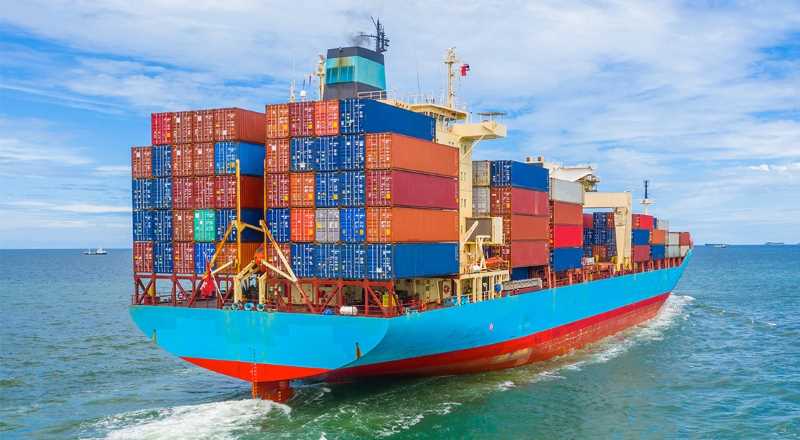Economy
Ocean Freight Rates Hit Historic Lows as Consumer Demand Slumps
Dismal Freight Rates Worry Ship Operators
Container shipping rates, which were once at pandemic-induced highs, have experienced a precipitous drop, casting a shadow over ocean freight carriers during the peak season. In September, daily Freight Rates for moving cargo from Asia to the U.S. and Europe tumbled by up to 90% compared to early 2022, posing a significant challenge for ship operators who find many voyages unprofitable at these current rates.
Mass Cancellations and Mothballing Ships
Major container carriers have responded by canceling numerous sailings throughout the year, with a focus on routes from Chinese ports to the U.S. West Coast. Data from shipping platform Xeneta suggests that additional cancellations are imminent this October, following China’s Golden Week holiday. This period sees manufacturing sites idled, according to industry insiders.
To mitigate operating costs, ship operators have been mothballing vessels, leading to a 7% reduction in container capacity in September compared to the same month in the previous year.
Industry Giants Brace for Leaner Times
Companies like A.P. Moller-Maersk, Mediterranean Shipping, and CMA CGM had been preparing for leaner times this year after enjoying a surge in business and profits during the COVID-19 pandemic. For instance, Maersk, often considered a global trade indicator, reported a second-quarter profit of $2.9 billion in August, down significantly from the $10.3 billion posted during the same period the year before.
Mixed Fortunes for Retailers
While these lower shipping rates provide relief for large retailers and shipping clients, who faced steep price hikes and capacity constraints during the pandemic, they also reflect a broader trend of caution among major shippers, who are growing increasingly hesitant about placing significant orders for goods.
Acquire the print version of The Wall Street Journal for 2 years
Deviation from Seasonal Norms
Typically, retailers such as Amazon.com, Target, and Walmart would boost their cargo intake during the summer months leading up to the year-end shopping season, prompting carriers to deploy more ships to meet the heightened demand. However, this year has seen an ongoing trend of low prices and subdued demand. Furthermore, wholesale inventories, while experiencing slight reductions in recent months, remain significantly higher than pre-pandemic levels, suggesting that orders for goods are unlikely to rebound in the near term.
Impact Across the Supply Chain
The effects of the shipping industry’s challenges are also being felt in other modes of freight transportation, as weaker demand and industry shakeouts take their toll.
Consumer Confidence Drops
For consumers, this environment of uncertainty is reflected in the drop in U.S. consumer confidence to a four-month low in September. Concerns about rising prices and the potential for an economic downturn have weighed on sentiment, although optimism about the labor market remains relatively intact. In fact, hiring has surged, with 336,000 new jobs added in September, marking the highest monthly increase since January.
Ports Handling Fewer Containers
The impact of the subdued peak season is evident in the two largest entry points for Asian exports to the U.S., the ports of Los Angeles and Long Beach in California, which are handling fewer containers than expected.
Shifts in Freight Rates Contracts
Large cargo owners often secure favorable shipping rates through long-term contracts lasting up to a year. However, when spot market rates collapse, shippers often seek renegotiation. Reports suggest that large retailers have seen an average 45% reduction in ocean shipping expenses this year, prompting some to actively negotiate lower prices on long-term freight contracts signed in the previous year or earlier this year.
Uncertain Future
As Peter Sand, the chief analyst at Xeneta, points out, “There is little visibility going forward. Carriers are negotiating with shippers weekly over rates.” While major carriers do not publicly disclose the details of their freight contracts, data from Xeneta indicates a 69% decrease in the number of long-term contracts signed with major shippers over the past three months.
East Coast Gains, but Challenges Persist
In an attempt to attract business, shipowners are redirecting available vessels to the East Coast, offering American importers from Europe some of the lowest transport costs in years.
Growing Concerns About Capacity
An even more concerning sign for pricing is the increasing delivery of boxships over the next year. Fleet capacity for the year through September increased by 4.7%, while container trade demand decreased by 2.3%, according to the London-based shipping broker Braemar. Braemar estimates show that overall fleet capacity is set to rise by 8.3% this year and 8.9% next year, potentially exacerbating the challenges faced by the industry.
Industry Adapts to Challenging Times
Analyst Jonathan Roach of Braemar noted, “Liners are reviewing capacity management to include aggressive demolition, long-term blanked sailings, and considering delaying newbuildings, depending on how distressed the market becomes.”
As the global shipping industry navigates these ongoing challenges, it remains uncertain when and how it will recover from this period of historic lows in freight rates.


